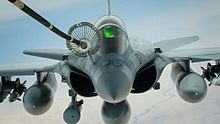Air refueling tanks

With an air refueling tank , transport or combat aircraft can be converted into tanker aircraft . An attachment takes place either on external load carriers under the wings or under the fuselage.
Air refueling pods can be used to refuel aircraft in the air using the probe and drogue method .
Components
In the air refueling container there is usually a fuel reservoir, a fuel pump, the extendable flexible hose, the folded collecting basket and the necessary components for operating the pod, such as the winch device and the required hydraulic pump.
A dynamic pressure turbine is attached to the nose of the container to drive the hydraulic pump, among other things, and the signal and warning lights at the rear.
In the event that the hose no longer retracts, a guillotine is installed with which the hose can be cut.
A (retrofittable) control panel is required in the aircraft with which the functions of the pod can be controlled.
Refueling process
- Preparation: When a receiving aircraft (receiver) reaches the tanker, it activates the rotor to drive the pumps and extends the approximately 12–20 meter long refueling hose. The collecting basket with a diameter of around 70 centimeters spreads in the wind stream. The signal lights switch from red to orange.
- Fuel transfer: The receiver behind the tanker flies its refueling boom into the coupling of the collecting basket with a slight difference in speed (approx. 3–4 knots ; approx. 6 km / h). When it is locked, the fuel begins to flow, the signals light up green. At night, the recipient primarily uses a reflector on the edge of the grass catcher in conjunction with a light on the boom for safe contact. The receiver pushes the hose back into the pod approx. 2 m and tries to keep this position relative to the tanker. For orientation purposes, reference marks are attached to the hose to help estimate the furthest and closest approach to the tanker.
- Refilling / disconnection: Before the tank of the refueling tank is empty, fuel is refilled from the tanker. After the required or maximum available fuel quantity has been reached, the process can be ended either by the tanker via the control panel in the cockpit or on the receiver side by disconnecting the coupling in the collecting basket.
- Quick disconnection (breakaway): If a quick disconnection is required (breakaway), the tanker switches red flashing lights. In this case, the recipient must immediately separate from the grass catcher.
Examples of fuel tanks
(each in various modifications)
- Sargent Fletcher Buddy Stores (e.g. for Tornado , F / A-18E / F )
- Sargent Fletcher Wing-Mounted Pod Systems (e.g. C-130 , B-707 T / T )
- Flight Refueling Mk 32B (e.g. for A-310 , C-130 , KC-135 , KC-10 )
- Douglas Model D-704 Air Refueling Store (e.g. for A-4 , S-3 )
- Swesda UPAS-1 ( Russian УПАЗ-1, унифицированный подвесной агрегат заправки , transcription : unifizirowanny podwesnoi agregat saprawki, unified underhung flight refueling container ) (for example, for. Su-24 )
- Zvezda PAS-1MK (e.g. for MiG-29 )
Tanker planes with in-air refueling containers
Warplanes as tankers
A main reason for the (temporary) conversion of combat aircraft to tankers is that only a few air forces can afford the maintenance of a tanker fleet, although there is always a high demand (e.g. for training, transfer flights, etc.). The degree of flexibility and independence from external tankers is thus increased considerably.
In addition, there are special areas of application (e.g. flight operations of aircraft carriers ) that can not be served with large tank aircraft , or only to a limited extent.
The mutual in-flight refueling of combat aircraft is called buddy-buddy refueling.
Examples of combat aircraft that can / could be converted into a tanker with a refueling container: Panavia Tornado , the F / A-18 Super Hornet , A-4 Skyhawk , A-6 Intruder , A-7 Corsair II , S-3 Viking , Su -24M , Su-33 , MiG-29 , Mirage 2000 , Étendard IV .
Converted transport / passenger aircraft
Transport aircraft that are modularly equipped with a refueling capability (e.g. A310 MRTT and A330 MRTT ) are the exception.
As a rule, there is a permanent attachment. Examples are the B-707 T / T , KC-10 Extender or the Il-78 Midas .


